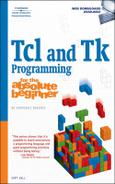Book Description
Tcl/Tk is enjoying a resurgence of popularity and interest in the computing community due to the fact that it is relatively easy to learn, powerful, fast, permits rapid development, and runs on all computing platforms. Until now, there has not been a guide book available that teaches Tcl/Tk to those with little or no programming experience. Covering the newest versions of Tcl and Tk, Tcl and Tk Programming for the Absolute Beginner teaches beginning and novice programmers concepts such as loops, conditional execution, input and output, and events, and shows readers how to implement these concepts using the grammar and syntax of the Tcl language. As part of the for the absolute beginner™ series, the book teaches all the concepts through the creation of simple computer games. Not only will this "learn by doing" approach provide you with an instant sense of accomplishment, but it's also a fun way to learn. Plus, in addition to learning Tcl and Tk, you'll also learn the basics of computer programming, so you'll have a solid foundation from which you can confidently jump to other programming languages.
Table of Contents
- Copyright
- Acknowledgments
- About the Author
- Introduction
- 1. Introducing Tcl and Tk
- 2. Running Tcl Programs
- 3. Doing Mathematics
- 4. Strings, Strings, Everywhere Strings!
- 5. Working with Lists
- Playing Blackjack
- What Is a Tcl List?
- Creating Lists
- Appending Lists
- Merging Lists
- Accessing List Elements
- Modifying Lists
- Searching and Sorting Lists
- Additional List Operations
- Looping with the foreach Command
- Conditional Execution: The switch Command
- Interrupting Loop Execution
- Analyzing Playing Blackjack
- 6. Creating and Using Arrays
- 7. Writing Tcl Procedures
- 8. Accessing Files and Directories
- 9. Understanding Tk Programming
- 10. Button Widgets
- 11. Windows, Frames, and Messages
- 12. Entry and Spinbox Widgets
- 13. Listbox Widgets
- 14. Scrollbar, Scale, and Text Widgets
- 15. The Canvas Widget
- A. Tcl Command Summary
- B. Tk Command Summary
